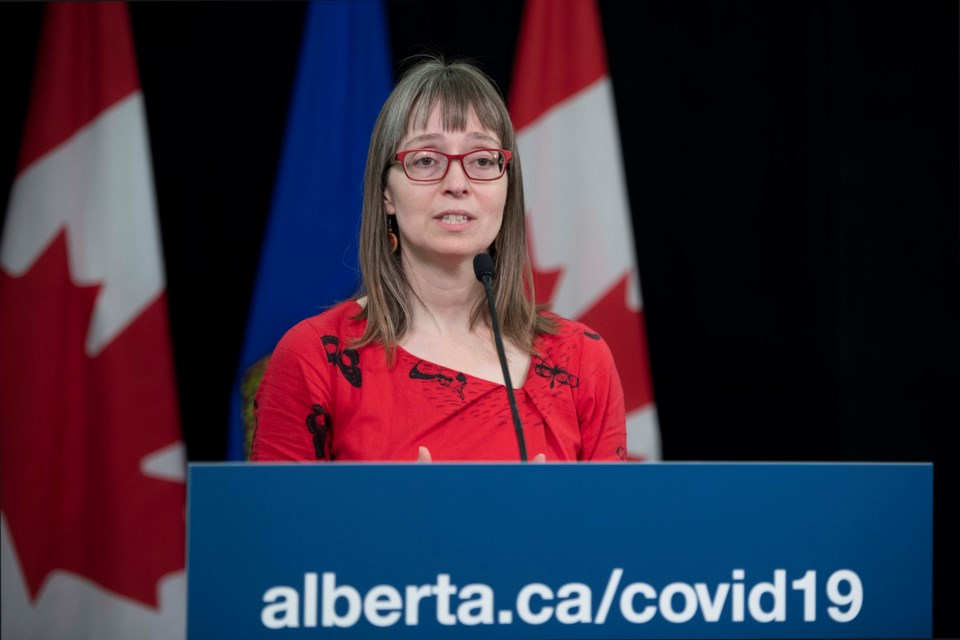The province’s chief medical officer of health cut right to the chase during her daily update Wednesday. Alberta has now topped 5,000 diagnoses of COVID-19.
There were 315 new cases, bringing the overall total to 5,165. The good news was that 1,953 people have since recovered from their illnesses.
The bad news was that the total of deaths from the disease is now at 87, an increase of seven since Tuesday. All of those came from Calgary long-term care facilities including six at Clifton Manor.
“I want to emphasize that this sad news is not a reflection of the work that has gone into managing this outbreak at the site, where my local colleagues tell me that the site responded promptly created an isolation ward and worked hard to prevent the spread. Despite this, this shows the power of this virus in a closed environment,” Dr. Deena Hinshaw stated.
There are now 503 cases that have been reported in continuing care facilities across the province. Additionally, there have been 821 confirmed cases among workers at the Cargill meatpacking plant in High River and an additional 276 cases among members, employees and contractors at the JBS meat plant in Brooks.
“We've taken every outbreak seriously and have used our fundamental outbreak control principles to limit spread in settings of concern. We have also continuously refined our strategy to identify and respond to outbreaks based on new learnings about this virus as new information becomes available,” she continued.
- INTERACTIVE MAP: See the latest COVID-19 statistics across Canada by province/territory on our interactive map
- RELATED: Cargill beef plant to reopen next week after COVID-19 outbreak forced closure
Hinshaw explained that effective outbreak co-ordination depends on close co-ordination between multiple partners.
The province has a three-pronged pandemic control strategy including prevention and preparedness, rapid response and timely notification, and outbreak management.
She addressed how the tactics of outbreak management also come with negative impacts on people’s quality of life.
“As we learn to live with COVID, we need to continue to make adjustments.”
In making those adjustments, she amended some existing directives designed to ensure continued protection of residents in continuing care facilities, while also improving their quality of life.
Anyone in those facilities who presents milder symptoms (such as a hoarse voice or muscle aches) must immediately be tested and isolated until results come back. Once a COVID-19 case is identified, all residents in the same unit will also be tested even if they are feeling fine and show no symptoms.
“Although testing someone without symptoms is only a snapshot in time, and does not stop the need to isolate for 14 days in close contacts of confirmed cases, it can help to identify cases before symptoms start helping to better control an outbreak,” she emphasized.
To protect the health of workers, any staff member caring for an isolated resident must also wear eye protection, along with all other appropriate personal protective equipment, including a gown, mask, visor and gloves.
Other health measures – such as requiring all staff to wear masks through the duration of their shifts in all of these facilities, and requiring workers in long-term care and designated supportive living facilities to work at only one location – remain in effect. They might increase residents’ sense of isolation but they are necessary tools in the fight against the pandemic.
She issued a second new order to take into account that restrictions might be in place indefinitely and also to help improve residents’ quality of life. The new order will allow non-isolated residents of these facilities to enjoy outdoor visits with a designated essential visitor and one other person. All appropriate precautions must be taken to prevent exposure to COVID-19.
Restricting visitors is one of the keys in preventing the spread, but she did admit there have been some palliative and end-of-life situations that have come to her attention where it has been applied more restrictively than was intended.
“We expect that individuals who are dying should have the opportunity to have their loved ones at their side by following the guidance in place to ensure everyone's safety.”
Up to two visitors at a time will be allowed to visit a person who is dying as long as physical distancing can be maintained between them. Standalone hospice facilities are not affected by these measures, she added, and as such no visitor restrictions are applicable there.
Alberta Health Services has set up a toll-free phone line to make it easy for any operator of any congregate care site in the province to get immediate support and guidance on how to respond to a resident or staff who have symptoms related to COVID.
Hinshaw also signed a new order to affect standards at all residential addiction treatment facilities, effective today. This order recognizes that these facilities have different and unique needs than continuing care facilities. It allows special accommodations for group therapy and to support the shorter residency of clients. It will still work to prevent the risk of infection while allowing individuals to continue to receive treatment and overcome their addiction.
There have been 36 cases, 13 active, of COVID-19 reported in Rocky View County and 18 cases, six active, reported in the Cochrane-Springbank region.



